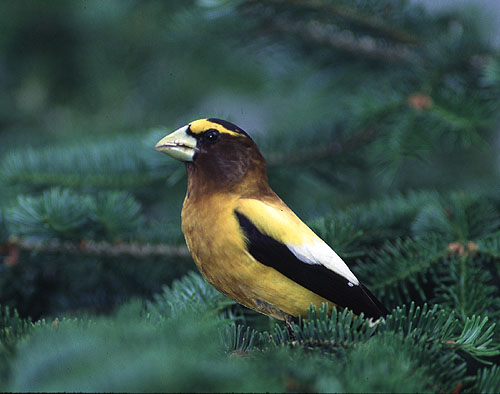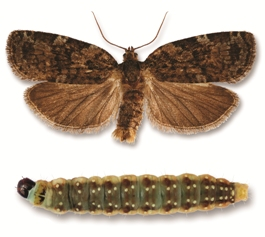Posted by Cindy Boucher
Evening Grosbeak
Spruce Budworm: Moth and Larvae Stage
“Everything we do affects something else.”
This statement stayed with me in a recent conversation about the Evening Grosbeak presence in New Brunswick during the 70 & 80’s. Let me explain.
During those years people recalled incredible numbers of Evening Grosbeak populations in the woods. So many in fact, that car accidents were said to have occurred due to the large numbers that gathered on the roads in search of road salt and grit. The “word” on the street was that these birds had been brought into New Brunswick to help combat the Spruce Budworm epidemic. Now this caught my attention. My warped sense of humor envisioned harried truck drivers transporting hundreds of protesting Grosbeaks to the province. Somehow, this didn’t add up. So, this prompted some research into the topic.
Evening Grosbeaks mainly eat Spruce Budworms during breeding and nesting season. It would make sense that this migratory species would make their way east for the insects that were so plentiful during the years of the outbreak. Since each Grosbeak can eat around 1000 budworms/day I can only surmise that huge flocks could decrease numbers by a fair amount. While this number sounds large, New Brunswick was dealing with a serious infestation and the wood industry was feeling the effects. Their solution was to spray and cut the wood in hopes of avoiding catastrophic losses.
After the spray program, numbers declined sharply in the Evening Grosbeak population. Rumors have it that hundreds of these birds were found dead in these hot zones. Yes, we know these birds are an irruptive species but the reality is that a serious look on the internet reveals a common truth: these birds have decreased in population and we don’t really know what happened. Whether this is a natural occurrence or they became casualties to the spray program it is important to understand why and what can be done to avoid future losses like this one. Remember my opening remark, “Everything we do affects something else”. Well, here was a clear case of the birds doing what they do naturally and as a result were decreasing the budworm population when human intervention steps in to save the industry. Now, this is not to slam anyone, this is about opening up to other solutions to reduce the impact on both species and environment. Since most of us use paper products of some sort what could be considered to prevent the needless death of so many birds but also keep the industry alive? There has to be a healthier solution.
After reading pages and pages of information I wonder if another way to approach this issue would be to not plant monoculture forests and plant multi-species plantations instead. Since the Spruce Budworms become out of control where single species are grown, maybe we could switch to multi -species and let the Evening Grosbeaks and Mother Nature work on the rest thus keeping human intervention at a minimum? Observations suggest that when varied plantations are created the numbers of Spruce Budworm remain manageable. Perhaps this would be a direction worth researching further. Tangent to this, an interesting comment that was made to me today regarding just this topic. A senior member of the community shared, back in the 80’s, that if they continued to plant one stand of anything they would eventually upset the scales thus creating major problems for industry later as issues would surface. Would appear he was correct as New Brunswick is forecasting another infestation of Spruce Budworm within 10 years. Let’s hope there have been better solutions discovered.
I look forward to hearing your comments, opinions and research on this topic. If any of you have more information I would be very interested in learning more.





Having lived in the Lanaudiere area of Quebec for the last 50 years I have always wondered why the
number of Grosbeaks have disappeared from my bird feeders for the last 20 years. I have not seen a single Grosbeak since those years when we had incredible numbers here. I blame the various Provincial
Governments for this catastrophe. The politician’s unholy alliance with the forestry and mining industries has been well documented. Unless this situation changes, wildlife of all kinds will continue to be decimated.
Thanks for the Tails of Birding link – it’s a superb blog!
The planting of monoculture Lodgepole Pine stands to replace clear-cut forests about a century ago has also helped to create ideal conditions now for the Mountain Pine Beetle, which is devastating our western pine forests.
What an excellent question. You made me wonder about their name as well so I did a little digging. There is an excellent article on the origin of their scientific and common names on the Tails of Birding blog. They are now placed in the same Genus as the European Hawfinch, but they still don’t ‘sing’ in the evening!
Great blog and good observations! Will post further reflections about all this tonight, if I can.
Commercial forestry just doesn’t get it. Spray the caterpillars and you also spray its predators and parasites. Beautiful as they are, I doubt if Evening Grosbeaks have any effect on budworm numbers, but other insects probably would. Their populations can rise in step with the budworm and overwhelm it. Spray them and what do you get: another budworm outbreak in a few years time.
Anyway what damage do the budworms actually cause? Do they kill the trees? Most defoliating caterpillars here in Europe may cause foresters to panic, but the tree just misses a growth year and comes back next year when the caterpillar population has,inevitably, crashed.
Mixed plantations would harbour more predators and would help, but the main thing is to stop spraying.
While I’m here can anyone tell me why they are called Evening Grosbeak? I have a romantic vision of a pioneer frontiersman trudging back to his log cabin after a hard day’s woodchopping and namimg them after watching them coming in to roost in the treetops (like our European Hawfinches).
Multi-species planting would be the solution to almost all conservation problems, as it re-creates natural forest and habitat. The forestry industry, however, prefers monoculture plantations for easy of harvesting. Guess who wins.